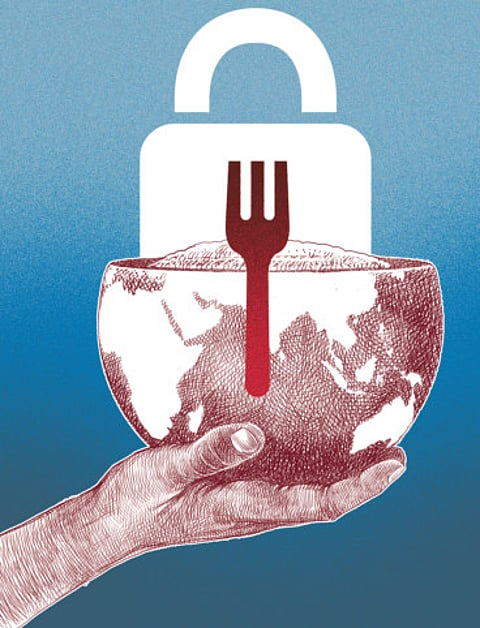Dynamics that make up UAE's ranking in Global Food Security Index
Having fund resources is only part of still evolving parameters deciding food security

In 2017, the Economist Intelligence Unit (EIU) introduced a fourth pillar to its Global Food Security Index (GFSI).
Named ‘Natural Resources and Resilience’, it was first considered as an adjustment factor to the GFSI. The GFSI calculated scores and subsequent rankings for countries based on three main pillars - affordability of food, its availability, and its quality and safety.
In a nutshell, the GFSI quantified food security by measuring access to food, the first and second pillars. Meanwhile, it accounted for its nutritional value through measurement of the third pillar.
When its fourth pillar was introduced, the GFSI ranked the UAE 33rd globally and fifth in the GCC. Singapore, a country that the UAE is quite comparable to in terms of dependence on food imports for food security, ranked fourth globally in 2017.
In 2020, the GFSI incorporated its fourth pillar into the overall scoring and ranking. As a result, Singapore dropped from first place in 2019 to 19th in the GFSI’s 2020 overall rankings.
The UAE’s drop was even more significant. Though it retained its fifth place among GCC member states, its global ranking dropped from 22nd in 2019 to 42nd in 2020.
What happened here?
To better answer the above question, one must consider what the fourth pillar looks into and where did both countries rank before its inclusion in the main index. The fourth pillar focuses on the association between climate change risks and food security, which, as the name suggests, assesses the resilience of countries in dealing with such risks.
When the fourth pillar was first introduced in 2017, it singled out Singapore and the UAE, among a handful of countries, to explain the improvement or worsening in their rankings when the fourth pillar was introduced as an adjustment factor.
Nature-led risks
According to the Natural Resources and Resilience pillar, Singapore ranked 106th, 103rd, and 109th in 2017, 2018, and 2019 respectively because of its overdependence on food imports and being highly susceptible to ‘rising sea levels and extreme weather events’.
Likewise, the UAE ranked the 113th in 2017, 113th in 2018, and 106th in 2019 due to its “susceptibility to drought, storm severity and rising sea levels”. Notably, both countries ranked among the top fifty worldwide in the same years when GFSI rankings were adjusted using the fourth pillar.
Even though the GFSI does not directly capture food production as guaranteed access to food, it is, as of the moment, the go-to index to understand a country’s food security status. With that, it is key to look at how including the fourth pillar has affected countries like Singapore and the UAE, both highly dependent on food imports. And how is it going to affect them as future versions of the GFSI are published.
What's in store
While the 2017 version provided insights into what affected the rankings of both countries, the varying degree by which these were affected could provide clues as to how they are going to perform in future. Mainly, how each country has mitigated risks related to their reliance on food imports.
For countries dependent on food imports for their food security, there are two factors that could impact how well they can do to ensure availability at all times. One, the ability to pay for food imports. Two, diversification of import sources that also translates into improved access to food in times of crisis.
On the first, both countries possess some of the highest incomes globally. Data from the World Bank ranks Singapore and the UAE among the Top 10 in Gross Domestic Product (GDP) per capita, adjusted by Purchasing Power Parity (PPP) in dollars. This means, regardless of sources of revenues, both countries should be able to pay for food imports in the foreseeable future.
Oil driven
In UAE’s case, its significant drop in the GFSI’s 2020 rankings could be under the premise that lower oil prices in 2020 may have hampered the UAE’s financial prowess to pay for food imports, if not for its vast foreign currency reserves and Sovereign Wealth Fund.
Secondly, Singapore managing to stay within the Top 20 places in the 2020 version of the GFSI, as the UAE dropped to 42nd place from its 22nd ranking in 2019, could be attributed to Singapore’s more diversified approach when sourcing food imports.
Source from all
Singapore, for instance, prides itself in being able to import its food from more than 165 countries. Interestingly enough, and during the COVID-19 crisis, Singapore published an infographic that captures such diversification by showing where the different components used in the making of a single sushi come from.
Though it cannot be ascertained from the GFSI how diversification in food import sources could impact rankings, since diversification is not clearly stated under any of the pillars, it is important in formulating a country’s food security strategy. Being captured by the GFSI is another matter altogether.
Despite its shortcomings, the GFSI is crucial in evaluating the food security. The focus in this column on food importing countries comes as a result of the GFSI’s preliminary focus on non-production related factors when ranking countries.
The EIU’s most recent move to incorporate the GFSI’s fourth pillar is a step in the right direction to bridge the food security narrative between food producing and food importing countries. However, more needs to be done to better measure and understand future food security prospects for importing countries.
The last thought that I want to leave you with: Can economic growth improve food security?
Sign up for the Daily Briefing
Get the latest news and updates straight to your inbox










